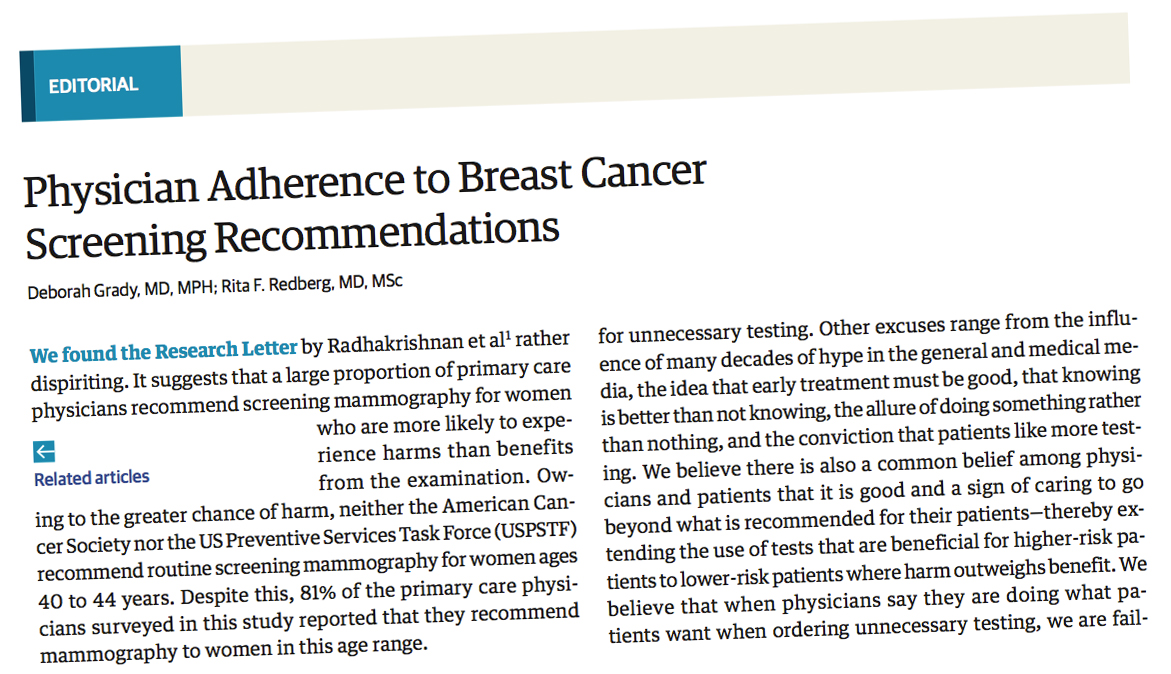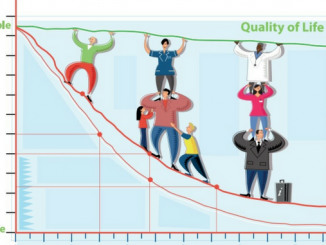When it comes to breast cancer screening with mammography, are women receiving a coherent message about the best age to start and to stop, and about frequency? A survey examined the situation in the United States, and concluded that at least three different guidelines inform the medical practice, with somehow conflicting messages, and a different balance between expected benefits and expected risks. Risks that – as it is well explained for instance on the website of Cancer Research UK – include not only the exposure to a small amount of radiation but especially an increase of overdiagnosis and overtreatment.
 «In a nationally representative sample of physicians, we found that primary care physicians (PCP) and gynecologists largely recommended screening to women 40 years or older» write Archana Radhakrishnan, of Johns Hopkins University in Baltimore, Maryland, and colleagues in a research letter just published on Jama Internal Medicine. «Our findings are largely consistent with a 2014 survey of PCPs from 4 clinical networks where similar proportions of physicians recommended screening with higher rates noted among gynecologists. We also found sharp differences in recommendations based on which guidelines physicians trusted most, which may suggest that current practices reflect both varying adherence to guidelines as well as differences in which guidelines are trusted. The results provide an important benchmark as guidelines continue evolving and underscore the need to delineate barriers and facilitators to implementing guidelines in clinical practice».
«In a nationally representative sample of physicians, we found that primary care physicians (PCP) and gynecologists largely recommended screening to women 40 years or older» write Archana Radhakrishnan, of Johns Hopkins University in Baltimore, Maryland, and colleagues in a research letter just published on Jama Internal Medicine. «Our findings are largely consistent with a 2014 survey of PCPs from 4 clinical networks where similar proportions of physicians recommended screening with higher rates noted among gynecologists. We also found sharp differences in recommendations based on which guidelines physicians trusted most, which may suggest that current practices reflect both varying adherence to guidelines as well as differences in which guidelines are trusted. The results provide an important benchmark as guidelines continue evolving and underscore the need to delineate barriers and facilitators to implementing guidelines in clinical practice».
In the US, the most extreme recommendations come from the American Congress of Obstetricians and Gynecologists (ACOG): yearly mammograms for women 40 and older. A little more cautious is the American Cancer Society (ACS), that in its revised guidelines suggested to personalize screening decisions for women 40 to 44, then start annual screening from the age of 45 to 55, followed by biennial testing. The 2016 recommendations by the U.S. Preventive Services Task Force (USPSTF) are even more worried of the likely risk of overdiagnosis and overtreatment, and suggest a personalized approach for women 40 to 49, then biennial mammograms until the age of 74.
in England, the screening programme is currently extending the age range to include women from 47 to 73 years old (to be tested every three years), while in Italy and France health authorities recommend starting at 50 and continue until 69 and 74, respectively, and repeat every two years.
According to the research letter by Archana Radhakrishnan, the attitude in the US is much more favourable to screening, despite the potential risks: 81 percent of US physicians recommend screening to women 40 to 44; 88 percent to women 45 to 49; and 67 percent for women 75 or older. Gynecologists were more likely to recommend screening for women of all ages compared with internal medicine and general practitioners. Among clinicians who recommend screening, most recommend annual examinations.
«We need to reduce the many factors driving the continued use of tests of questionable value or known to be harmful. Ultimately, alternative payment systems that value evidence-based, patient-centered outcomes would improve patient care, choice, and satisfaction while decreasing wasteful spending» comment in the accompanying edtorial Rita Redberg – who is Jama Internal Medicine’s editor in chief – and Deborah Grady, after endorsing the USPSTF guidelines as «the most evidence-based, transparent, and conflict-free».






Leave a Reply